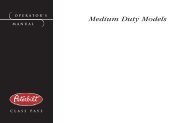Peterbilt Medium Duty Truck Owner's Manual - Peterbilt Motors
Peterbilt Medium Duty Truck Owner's Manual - Peterbilt Motors
Peterbilt Medium Duty Truck Owner's Manual - Peterbilt Motors
Create successful ePaper yourself
Turn your PDF publications into a flip-book with our unique Google optimized e-Paper software.
Preventive Maintenance<br />
reduced braking capability). Other vehicles use a Bendix<br />
AD-IS air dryer which eliminates the need for a wet tank<br />
and check valves in the dry tanks.<br />
NOTE: A small amount of oil in the system may be<br />
normal and should not, by itself, be considered<br />
reason to replace a desiccant cartridge; oil-stained<br />
desiccant can function adequately.<br />
Every 900 operating hours or 25,000 miles/40,000 km or 3<br />
months, check for moisture in the air brake system by opening<br />
reservoirs, drain cocks, or valves and checking for the<br />
presence of water. A tablespoon of water in a reservoir would<br />
point to the need for a desiccant cartridge change. However,<br />
the following should be considered first:<br />
• Air usage is exceptionally high/abnormal for a highway<br />
vehicle. This may be due to accessory air demands or<br />
some other unusual air requirement that doesn’t allow<br />
the compressor to load/unload in a normal fashion or it<br />
may be due to excessive leaks in the air system.<br />
• When more than a 30-degree F. (17-degree C) range of<br />
temperature occurs in one day, small amounts of water<br />
can accumulate in the air brake system due to condensation.<br />
Under these conditions, the presence of small<br />
Air System<br />
amounts of moisture is normal and should not be considered<br />
as an indication that the dryer is not performing<br />
properly.<br />
• An outside air source may have been used to charge the<br />
air system, in which case this air did not pass through<br />
the drying bed.<br />
Air Intake System<br />
Engine heat, vibration, and age combine to loosen air intake<br />
connections and cause cracks in the tubing and elbows.<br />
Leaks in the intake system allow abrasive dust to enter the<br />
engine and quickly cause expensive damage. During your<br />
daily walk-around inspection, carefully check all tubing,<br />
elbows, clamps supports and fasteners for condition and<br />
tightness.<br />
• Under normal operating conditions, <strong>Peterbilt</strong> recommends<br />
complete disassembly and cleaning of the air<br />
intake system at each 25,000 mile (40,000 km). Under<br />
severe operating conditions, the disassembly and cleaning<br />
should be more frequent. Replace any defective<br />
parts. With the possible exception of mounting brackets,<br />
do not repair defective parts.<br />
<strong>Medium</strong> <strong>Duty</strong> (R05/09) Y53-6027 – 201 –
















